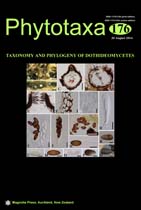Abstract
Pseudorobillarda is a coelomycete genus of Dothideomycetes with appendaged conidia and 15 species epithets. In this study, we isolated four strains of Pseudorobillarda from dead leaves in Thailand. DNA sequence data generated from the large subunit (28S) ribosomal DNA (nuLSU) gene was used in phylogenetic studies. The phylogenetic trees generated indicate that Pseudorobillarda form a distinct lineage in Dothideomycetes that may eventually require separate family status. The Pseudorobillarda strains comprised two distinct species and this is also supported by morphological characteristics. In this paper we introduce a new species of Pseudorobillarda, P. eucalypti and compare it with other species of the genus. We also deposit data from the internal transcribed spacer (ITS), small subunit (18S) ribosomal DNA (nuSSU),the RNA polymerase II 2nd largest subunit genes (RPB2), Translation Elongation Factor 1-α (TEF1-α) and β-Tubulin (Bt) genes from each strain in GenBank for future studies.

